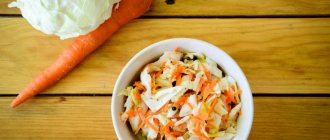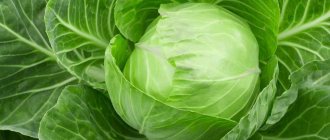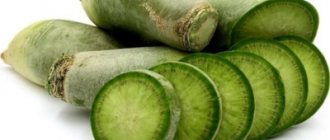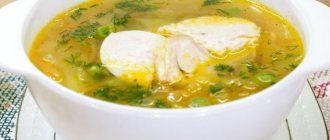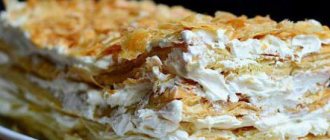Nutritional value of white cabbage
White cabbage is a source of many vitamins and minerals. It not only helps to reduce excess weight during diets, but also saturates the body with microelements. The secret of these properties lies in the chemical composition of the product, including white cabbage is saturated with the following beneficial substances:
- Iodine;
- Magnesium;
- Sodium;
Read: Calorie content of boiled white cabbage
- Manganese;
- Phosphorus;
- Vitamins of groups A, B, C, E, H.
The content of macro and microelements, as you can see, is at a very high level, while the amount of fat and calories in the vegetable is extremely low, both raw and cooked. Energy value of white cabbage:
- 2 grams or 10% of the daily value of dietary fiber;
- 90.5 grams of water or 3.53% of the daily value;
- 3.67% carbohydrates;
- 0.31% fat;
- 2.2% proteins.
If you add meat
Now let's look at how many kilocalories will be contained in stewed cabbage with added meat
.
First of all, it should be noted that the fat content of a dish directly depends on the proportions and energy value of additional ingredients. When preparing this dish, it is recommended to adhere to the following proportion: 70% vegetables, 30% meat.
- The energy value of a dish using minced chicken will be 102 kilocalories.
- The energy value of a dish with the addition of chicken breast will be about 150 kilocalories.
- By adding fat-free pork to the dish, its calorie content will be 145 kilocalories.
- If the vegetable is stewed with beef, then the energy value of this dish will be about 160 kilocalories per 100 grams.
Cabbage is a dietary food product. Moreover, it is extremely useful. It contains a lot of biologically active substances, vitamins, and minerals. Vegetable dishes are suitable for organizing a regular and therapeutic diet.
Let's consider how many calories are in cabbage, fresh, stewed, pickled.
Kbju white cabbage
Before including a particular product in your diet, it is better to calculate its main indicators:
- calorie content
- protein content,
- fat content,
- carbohydrate content.
Options for proper distribution of proteins, fats and carbohydrates in the diet:
- ½ of the nutrition is carbohydrates, the other half is 3/5 proteins and 2/5 fats;
- 2/5 – carbohydrates, 2/5 proteins, 1/5 – fats.
The content of proteins, fats and carbohydrates in white cabbage is as follows:
- Proteins – 1.8;
- Fats – 0.1;
- Carbohydrates – 6.8
It follows from this that the ratio of food in this vegetable is balanced and helps to reduce a person’s weight.
Read: Lenten dishes made from white cabbage
Proteins in white cabbage are responsible for metabolic processes in the body and form muscle cells. Carbohydrates are a source of nutrition for the normal functioning of all human vital systems: muscles, organs, cells, etc. Digesting foods high in carbohydrates does not cause apathy and drowsiness after eating.
The fats in white cabbage also have beneficial functions. They produce enormous amounts of energy during oxidation, protect the most fragile systems and organs in the human body, and also prevent the body from becoming hypothermic. The brain cannot function normally without fats; with fat deficiency, certain groups of vitamins are not absorbed, and the skin becomes dull and flakes.
Another important indicator of any product is calorie content. White cabbage contains 27 kcal for every 100 grams of product.
Fat enemies and diet friends
Before you find out how many calories are in stewed cabbage, you should immediately note that in this case we are talking about a white vegetable
. As you know, there are many varieties of this product: Savoy cabbage, Chinese cabbage, broccoli, cauliflower, Brussels sprouts. Moreover, each variety has its own calorie content.
We will talk about the energy value of the usual and simple white cabbage. It is also worth noting that the number of calories of this product directly depends on the method of preparation, as well as additional ingredients included in the dish.
Let's consider the energy value of the product
, taking into account that 100 g of stewed cabbage accounts for 70% of the main product and 30% of other ingredients.
- Cabbage stewed with carrots contains 40 kilocalories.
- White cabbage stewed with mushrooms contains 112 kilocalories per 100 grams of dish.
- Stewed vegetables, prepared with the addition of tomato paste and tomatoes, contain 99 kilocalories per 100 grams.
- A vegetable stewed with potatoes contains 124 kilocalories.
- If you do not add other vegetables during stewing, but use only vegetable oil as an additional ingredient, then the calorie content of this dish will be 50 kilocalories.
- Stewed cabbage, prepared absolutely without any additives, contains 40 kilocalories per 100 grams of product.
Considering how many calories are in stewed cabbage with other vegetables, it should be noted that this dish is indeed dietary
. Of course, the minimum energy value depends on how much water was added during cooking, and whether it was cooked without oil and other ingredients. But it is worth noting that many people quickly get bored with such a bland taste.
To consume as few calories as possible and get more pleasure, it is recommended to cook cabbage with the addition of carrots and vegetable oil. In this case, the calorie content of 100 grams of the dish will be 45 kilocalories.
You can also cook this vegetable with the addition of tomato and onion; this dish will have an unusual taste and lightness. To prepare a portion for 2 days
you will need the following ingredients:
- Fresh head of main vegetable;
- Two medium onions;
- Two medium tomatoes;
- One carrot;
- A little soy sauce;
- One teaspoon of olive or sunflower oil.
Chop the white cabbage, pour 300 ml of water into the pan, add oil. Finely chop the remaining vegetables and add to the pan. Mix all the ingredients thoroughly, then add two teaspoons of soy sauce, simmer everything until tender over low heat. 100 grams of a finished dish, as a rule, contains no more than 100 kilocalories. In order to reduce the energy value, it is recommended not to add oil.
Characteristics of white cabbage: glycemic index
White cabbage is indispensable in the world of diets. A balanced diet requires calculating several indicators, including the glycemic index.
Glycemic index - consists of a numerical scale from 0 to 100. Each consumed product can be measured using the index, it allows you to understand the amount of carbohydrates in food, as well as the speed of their elimination from the body. The higher the glycemic index scale, the worse the food you eat will affect your figure. If the number is minimal, then the product has a high content of fiber and complex carbohydrates.
In white cabbage, this indicator is 15, which means it takes a long time to digest and does not increase blood sugar levels. The glycemic index does not change depending on the type of preparation of cabbage, so during a diet it can be consumed in any form.
Portal about vegetables: recipes, varieties, storage, cultivation
Some people are tirelessly searching for dietary dishes in order not to gain weight, while others simply love to eat delicious food.
Food made from cabbage is suitable for both. Although it is dietary, it is not without taste. There are many different ways to stew cabbage. But nowadays people are so busy that they want to find recipes that do not require much time to prepare. A fashionable and popular device will come to the rescue - a multicooker!
Let's list a few simple ways to prepare cabbage.
Recipe No. 1
To stew cabbage you will need:
- half a medium-sized head of cabbage;
- 1 head of peeled onion;
- 6 pcs. medium sized tomatoes;
- 2 pcs. peeled carrots;
- 0.5 l. water;
- 2 pcs. pepper (bell pepper);
- spices to taste.
First, finely chop the cabbage, grate the carrots on a coarse grater, cut the onions and peppers into thin half rings, and the tomatoes into cubes. Next, put the vegetables together in a slow cooker, add water, spices and mix. Then you should close the lid of the device and set the extinguishing mode on the display, set the cooking for 40 minutes. After this time, the vegetables will be cooked.
The dish can be used as a side dish for meat. But if you stick to a low-calorie diet, you can cook rice or buckwheat with it.
Recipe No. 2
To stew cabbage with chicken you will need:
- 500 g chicken meat;
- 1 onion;
- 1 small head of cabbage or 0.5 large;
- tomato paste (fresh tomatoes will also work);
- spices to taste;
- 3 tablespoons sunflower oil;
- 0.5 glasses of water.
Carrots and onions need to be washed and peeled. Cut the onion into half rings and the carrots into thin slices. Chop the cabbage into small pieces. Wash the poultry meat, dry it, cut into small pieces. Then fry the onions and carrots in hot oil, and then throw in the chicken.
Close the multicooker lid and simmer for 5-10 minutes. Then, opening the lid of the device, add shredded cabbage with tomato paste (or tomatoes), spices, and pour water. Close the lid and cook in simmer mode for 20 minutes. Can be used both independently and as a side dish.
Recipe No. 3
To stew cabbage with zucchini you need to take:
- 0.5 kg cabbage;
- 2 small onions;
- 1 medium sized zucchini;
- tomato sauce (ketchup or fresh tomatoes will do);
- 1 large carrot (or 2 small ones).
When stewing in a slow cooker, first prepare the zucchini for cooking: cut in half, remove seeds and pulp. Then peel off the skin. If it is a young vegetable with a thin skin, you don’t have to peel it. Cut into medium sized cubes.
Next, heat the oil in a multi-cooker bowl, add thinly sliced carrots and onions. You should fry the vegetables a little while stirring. Then add shredded cabbage, zucchini cubes, adding spices and a little water. Zucchini and cabbage release their juice when stewed, so you don't need a lot of other liquid.
Then you need to mix everything well again. Close the lid of the multicooker tightly, set the simmer mode for 20 minutes and you're done!
To learn how to prepare dietary stewed cabbage, see the following video.
| Fats, g | 0.1 g |
| Proteins, g | 1 g |
| Carbohydrates, g | 3.1 g |
| Fats, g | 0.5 g |
| Proteins, g | 2 g |
| Carbohydrates, g | 3.4 g |
Nutritional properties may vary depending on the choice of mushrooms and other preparation features. Champignons are usually used, less often butter mushrooms and honey mushrooms. It is popular to use lard and fat instead of vegetable oil. Such a change in the recipe significantly increases the calorie content of the finished dish. There are several recipes that involve adding legumes and nuts. In this case, the calorie content of the products should be added up. If a dish is prepared for its low calorie content, it is better not to add anything to it.
| Type of cabbage and calorie content | What you need | Recipe |
| Stewed in water (17 kcal per 100 grams) |
|
|
| Stewed with mushrooms (38 kcal per 100 grams) |
|
|
Many people like the combination of vegetables and pork. Peculiarities of preparation and selection of products can make a dish not at all dietary. There is a recipe with which you can get a calorie content of about 110 kcal per 100 grams of the finished product.
To do this you need:
- 300 g lean pork;
- 1 kg of white cabbage;
- 200 g onions;
- 50 g vegetable oil;
- 100 g of tomato paste or ketchup;
- 8 g salt.
The onion is chopped and the meat is cut into cubes.
First of all, onions are fried in vegetable oil, then meat, and lastly shredded cabbage and salt. You can add black pepper and other spices to taste. 20 minutes before readiness, add ketchup or tomato paste.
The composition of cabbage is characterized by a high content of water (up to 90%) and fiber. Cabbage has excellent taste and many beneficial (dietary) properties. In terms of protein content, cabbage is superior to beets, turnips, rutabaga, carrots and many other vegetables.
Cabbage protein is a source of essential amino acids that are necessary for the functioning of the kidneys, thyroid gland, and hematopoietic processes.
Cabbage is the main supplier of rare vitamins: vitamin U and vitamin K. Vitamin U promotes the healing of stomach and duodenal ulcers. Cabbage is also a good source of vitamin C. Moreover, it remains in cabbage throughout the entire storage period. In smaller quantities, cabbage contains other vitamins: provitamin A (carotene), vitamins B1, B2, B3, provitamin D, vitamins P, PP, H.
Cabbage is very rich in fiber and contains virtually no starch or sucrose. Thanks to this, cabbage is very useful for diabetics and is recommended for people with increased body weight. Fiber normalizes intestinal microflora and removes excess cholesterol from the body. Cabbage contains the lactic acid we need. Cabbage contains minerals necessary for our body: calcium, potassium, magnesium, iron, phosphorus and other trace elements.
Carbohydrates in white cabbage for weight loss
Many nutritionists from all over the world agreed that white cabbage is the best way to combat excess weight, since it is absorbed by the body very slowly. The main thing that all dieters pay attention to is the number of calories contained in the product. There are two types of calories - simple and complex.
It should be remembered that not all carbohydrates are harmful to the body. They make the body work, give the body energy for mental and physical actions. For this reason, it is impossible to maintain a completely carbohydrate-free diet.
It is important to determine the type of carbohydrate contained in a food product. Simple carbohydrates are found in many fruits, flour and sweets. They are not recommended for use during a diet, because... are very quickly eliminated from the body, again arousing the feeling of hunger due to lack of energy. Complex carbohydrates, on the contrary, take a long time to digest, satisfy the appetite for a long time and are used up, do not form fat folds.
Read: Useful properties of white cabbage
In white cabbage, as in any other cabbage, the carbohydrate level is low and is only 6.8. The vegetable contains complex carbohydrates, which is why doctors recommend consuming the product while losing excess weight.
Calorie content of cabbage stewed with tomato paste
Very often, cabbage is stewed with tomato paste, which somewhat changes its taste and color. To prepare this dish you will need:
- white cabbage 850 g
- water 600 g;
- onions 40 g;
- olive oil 60 g;
- tomato paste 80 g;
- carrots 90 g.
Heat a frying pan well with oil, add shredded cabbage, fry a little, add grated carrots, finely chopped onion, salt and pepper. In a small container, mix tomato paste with water, pour into a frying pan, stir, cover with a lid, and simmer until tender.

